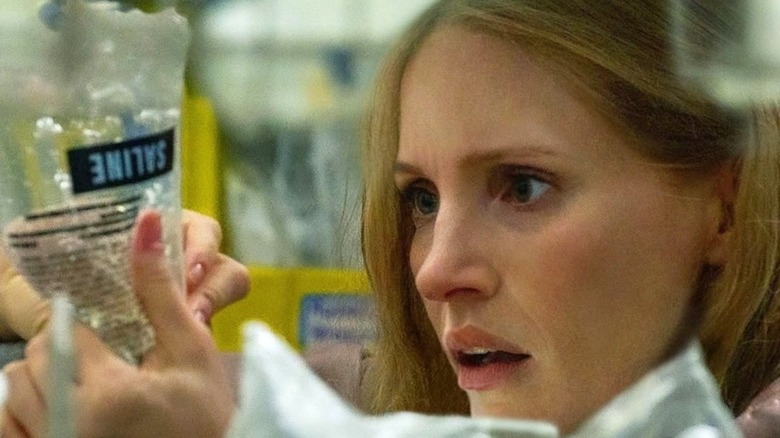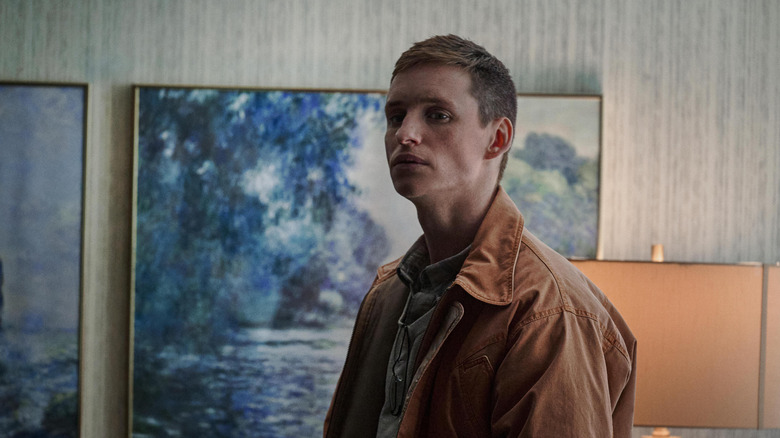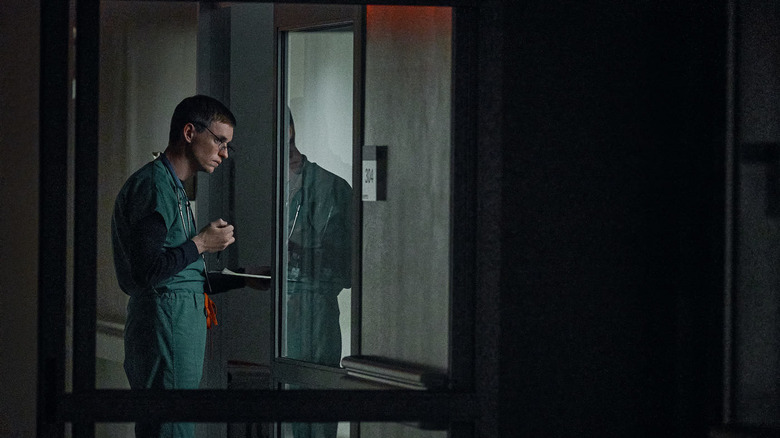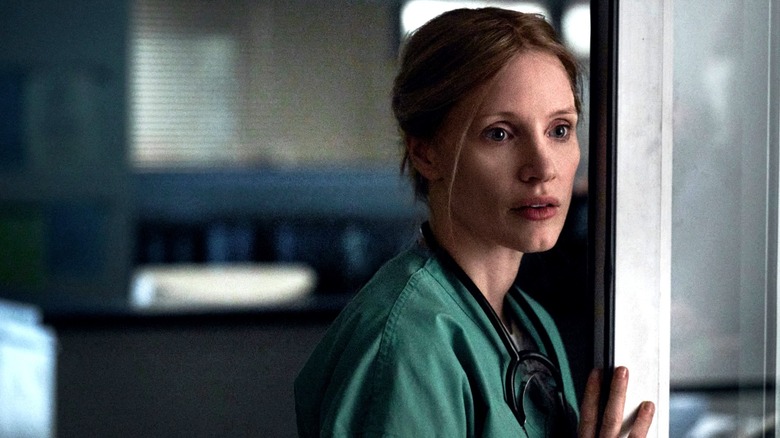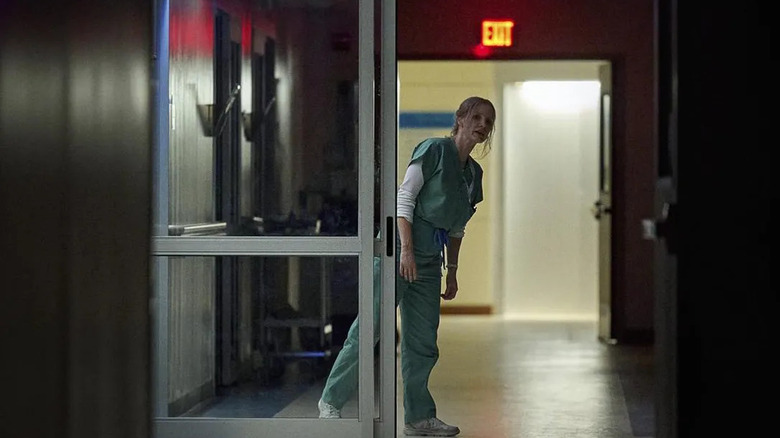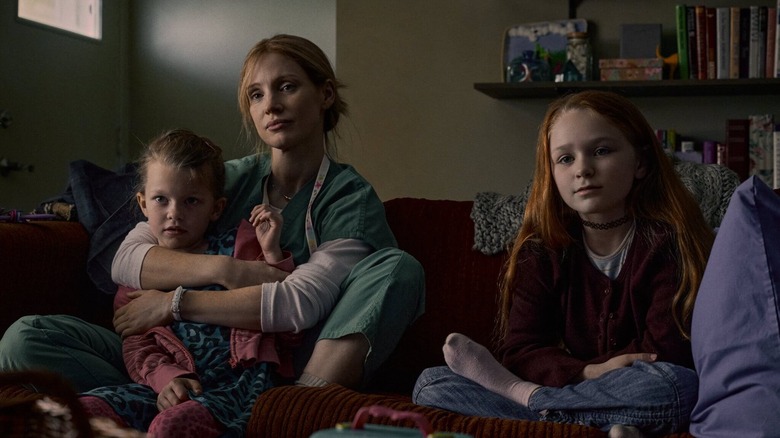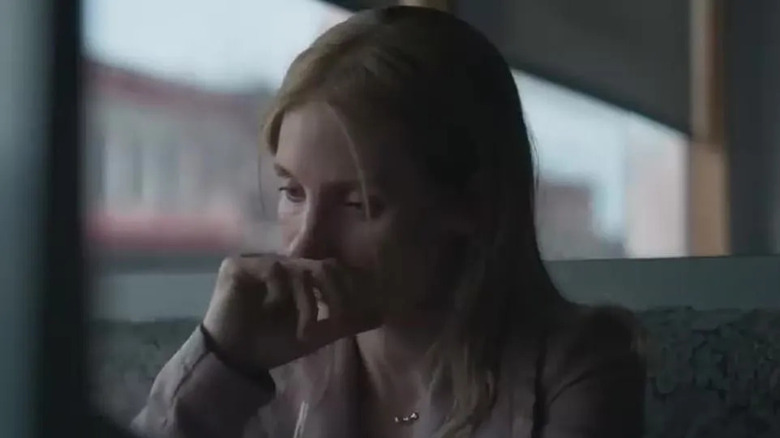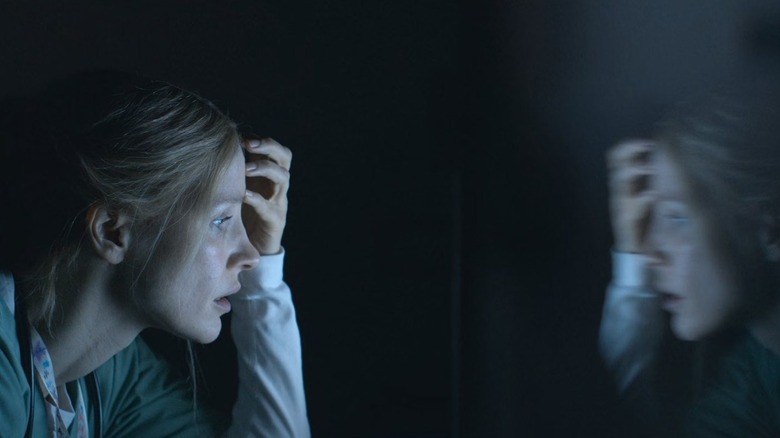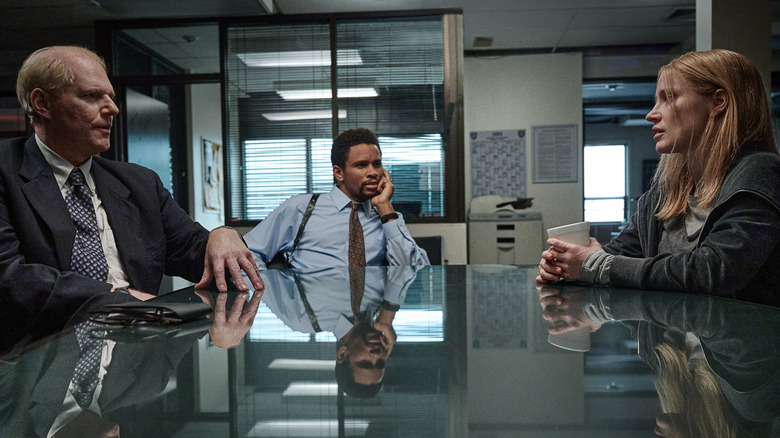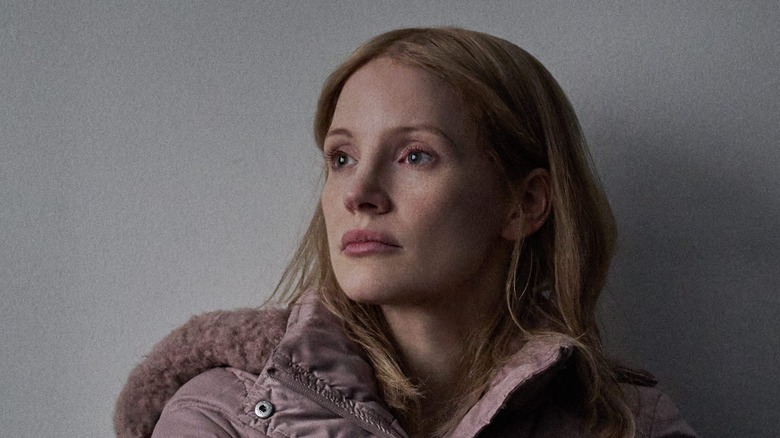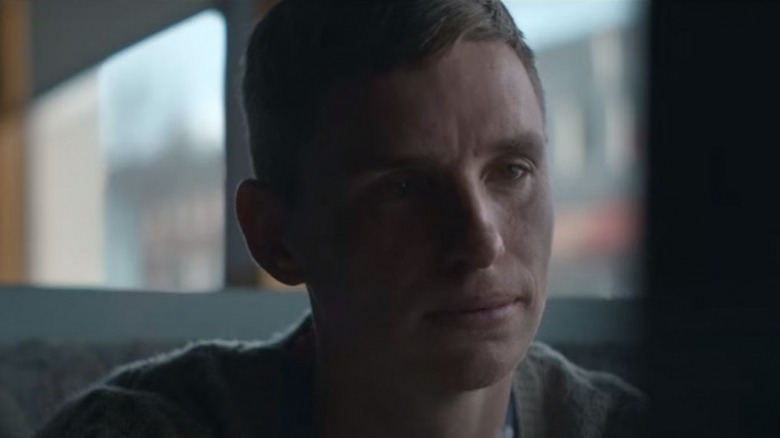Everything The Good Nurse Gets Wrong About The True Story
Netflix's true crime drama "The Good Nurse" is a surprisingly faithful adaptation of real-life events. During the late 1980s to the early 2000s, a nurse named Charles Cullen killed between 29-400 patients by contaminating their saline bags with insulin and another drug called digoxin. He wasn't criminally charged for so long because, in large part, the hospitals that employed him and his co-workers were hesitant to speak up for fear of being sued, losing their jobs, or being targeted by the Cullen. Since nobody stopped him until Amy Loughren stepped in, he became one of America's most prolific serial killers.
The film has to make a long story short. By far, the biggest change between local news accounts and the book of the same name that the film used as its source material is that "The Good Nurse" takes place over about five months — leading to Charles Cullen's (Eddie Redmayne) arrest and confession. The Netflix series focuses on his time with Amy (Jessica Chastain) — omitting details from his past (and future) to condense the narrative. In some cases, the film exaggerates and even downplays what happened when Charles suited up in his scrubs. Other details change for reasons of legality or sensitivity to the families involved. These are the notable differences between Charles and Amy's friendship in real life and on-screen, and we're here to explore them all.
Charles Cullen was a violent alcoholic
"The Good Nurse" depicts Charles Cullen as a socially awkward and possessive man with a chilling indifference towards people. In two of the movie's final scenes, Charlie goes into a fit of rage, so we see how little control he has over his impulses. The film's dialogue alludes to the fact that Charlie had previously harmed (and potentially killed) dogs with poison. But it leaves out a major detail at the heart of his divorce and loss of custody. Charles Cullen was a nightmare of a husband and father: He self-medicated his depression with alcohol rather than the pills he was prescribed and abused his family.
His then-wife Adrienne Taub attempted to get a restraining order, fearing he'd hurt her and their daughters. She kept him from unsupervised visits with their children. She claimed he drank excessively when alone with them and confided to the police that he had poisoned people. Shockingly, a judge at the time ruled that Cullen was guilty only of "odd behavior" and denied her request. When Charles broke into the house of another nurse and harassed her (as mentioned in the Netflix movie), the courts finally took Taub seriously. They granted her a temporary restraining order and took away his visitation rights. Charles' substance abuse was a big part of his life that's not a part of the movie.
If you or anyone you know needs help with addiction issues, help is available. Visit the Substance Abuse and Mental Health Services Administration website or contact SAMHSA's National Helpline at 1-800-662-HELP (4357).
If you or someone you know is dealing with domestic abuse, you can call the National Domestic Violence Hotline at 1−800−799−7233. You can also find more information, resources, and support at their website.
Charlie made several suicide attempts
Throughout "The Good Nurse," audiences suspect that Charles' mental health isn't in a great place. But the extent of his desperation isn't clear. The real Charles Cullen was as suicidal as he was homicidal. A psychological study about his case shows he made his first suicide attempt at age nine when he ingested the contents of his chemistry set. In 1993, Charles tried to kill himself three times. After the first two attempts in January and April of 1993, he sought treatment. Charles made another suicide attempt in August 1993 but didn't seek treatment afterward. He returned to work and murdered one of his victims three weeks later. From what we know, Charles tried to end his life at least eight times.
Netflix's "The Good Nurse" doesn't inform audiences about his suspect career in the military. In April 1978, he dropped out of high school to join the Navy. But he never fit in with his crew mates, who he claimed bullied him. However, he committed strange acts like wearing a stolen hospital gown and gloves while sitting at a nuclear control panel. He was written up for that incident, transferred, and eventually given a medical discharge — the details which have never been made public. Charles' psychological problems likely led to the Navy discharging him from service.
If you or anyone you know is having suicidal thoughts, please call the National Suicide Prevention Lifeline by dialing 988 or by calling 1-800-273-TALK (8255).
The names of the hospitals
"The Good Nurse" is correct when stating Charles Cullen worked at nine different hospitals over 16 years. The movie starts at St. Aloysius in Pennsylvania in 1996 and ends at Parkfield, New Jersey, in 2003. Along the way, Charlie tells various people he's worked at St. Elizabeth's, Florians, Vance, and Shawlands. Amy tracks down a woman she trained with at Shawlands to confirm her suspicions about her new friend and co-worker. In the end, the film tells us that while Charles received 18 life sentences for his crimes, none of the hospitals were held accountable.
Likely, "The Good Nurse" created fake names for the hospitals that employed Charlie for legal reasons. The real-life Amy Loughren hinted that some of these cases are still under "gag order," and details were changed to not emotionally damage those involved.
But how did hospitals let this happen? Previous criminal complaints against Charles were dismissed, so he didn't have a record to share with future employers. Hospitals fired him for trivial reasons, so his misconduct didn't have to be reported to subsequent workplaces. After graduating as the president of his nursing class, Charles got his first job at St. Barnabas Medical Center's burn ward in 1987. He killed his first victim in 1988. After St. Barnabas became suspicious, he worked at the following hospitals: Hunterdon Medical Center ICU, Morristown Memorial Hospital, Liberty Nursing Home, Easton Hospital, Lehigh Valley Hospital, St. Luke's, Sacred Heart, and Somerset Medical Center — which the film changes to be Parkfield. However, the movie keeps New Jersey and Pennsylvania, where all these facilities are, as its geographical base.
The names and stories of the victims have been changed
In the film, we meet two of Charlie's patients. The first is Ana Martinez (Judith Delgado), an elderly woman, who has a life-threatening reaction to an antibiotic. The second is a young mother, Kelly Anderson (Anjelica Bosboom). Both patients are fictional composite characters created for "The Good Nurse." Director Tobias Lindholm explained that he didn't feel comfortable re-creating a real person's murder for his movie because the suffering families have been through enough. Not only have the names been changed, but the patients' stories (and conditions) don't align 100 percent with reality.
Ana Martinez is representative of Cullen's typical victims. Of the murders we know about, most were elderly patients — although some were as young as their teens with prognoses of full recovery. His first murder was of New Jersey municipal judge John Yengo Sr, who was 72 years old and in treatment for severe sunburn. He also killed a 22-year-old car accident victim, Matthew Mattern. At Somerset, the last stop on his résumé, he killed at least 13 people and attempted to kill two others. Officers exhumed one of his final patients to confirm Cullen killed them. Since there is no definitive number attributed to Cullen's murders, probably, some of his victims don't even know they were victims of the notorious serial killer.
Charlie never met Amy's kids
One of the few areas where "The Good Nurse" takes some creative license is how Charles becomes close to Amy's daughters. He helps Alex rehearse her audition for the school play. Ominously, once Amy's pegged him as the killer, she comes home to him babysitting her kids. These two scenes create tense cinematic moments, but this never happened in real life. While Amy and Charlie became friends, and while that close friendship did help to put him in prison, their relationship wasn't as familial as the movie portrayed it.
According to Charles Graeber, the author of "The Good Nurse: A True Story of Medicine, Madness, and Murder," Charles would've known where Amy lived. However, he never would've met her children. Amy Loughren describes their rapport as funny and full of banter and adds that they were "trauma bonded" because of their difficult lives and jobs. Charles' bond with her daughters is one of the only flourishes that makes "The Good Nurse" feel like a standard true crime thriller, not a dual-character study. However, Amy's girls did know about Charles and the potential murders he committed, and they encouraged their mother to cooperate with the real-life Detectives Braun and Baldwin — even if it put the family at risk.
The diner meeting was much longer
In Netflix's "The Good Nurse," once Amy believes Charles is guilty, she seeks out detectives. However, they can't prove that Charlie took the insulin and digoxin after he canceled the orders. Sadly, they can't prove the hospital knew about it either. They need a confession before they can charge him with a crime. Amy agrees to wear a wire and meet him for lunch at a diner in hopes he'll talk. This tense scene plays out in a matter of minutes. While Amy primes him by taking his side and saying she would understand if he did it, he doesn't want to talk about Parkfield. When she pushes too hard, he leaves.
In real life, Amy said this high-stakes conversation lasted for hours. The audiotapes from the mic she wore, later used in Charles Graeber's book and documentaries, are about three hours long. "We were having just a regular afternoon beer with something to eat and just talking shop," she said. "I just kept building up to making sure that he understood that I did care about him and that we were friends." However, Charles' flipped-switch reaction happened just as in the movie. Amy also spent seven hours with Cullen in the interrogation room.
The hospital's stalling was even worse than depicted
The fictional Parkfield Hospital doesn't come off well in "The Good Nurse." They don't call the police until seven weeks after Ana Martinez dies. When they do, they impede Detective Braun's (Noah Emmerich) and Baldwin's (Nnamdi Asomugha) investigation at every turn. The hospital's internal investigation amounts to hiding or destroying documents that might've helped catch Charlie sooner. Administrators do the same thing every other healthcare facility had done: they fire him for the offense of putting April instead of May on his work application. Viewers might think filmmakers amped up the incompetence or villainy for effect, but the opposite is true.
Somerset Hospital sat on data for three months. During this time frame, Cullen killed five more patients — as opposed to the film's two — and nearly killed a sixth. They lied about the PYXIS system's capability to store data — as Parkfield execs do in the Netflix film — but the manufacturer of PYXIS set the record straight.
Poison Control got involved
Exactly when and why Detectives Braun and Baldwin become involved with Cullen's cast gets lost in the narrative of "The Good Nurse." One day, they show up at a conference room to speak with the hospital risk manager, Linda Garran (Kim Dickens). She informs them about Ana Martinez's suspicious passing. But the film leaves out the catalyst that jumpstarted bringing down Cullen. Likely, this choice helped the film focus on the personal story of Amy and Charles' friendship. Also, the Parkfield hospital looked negligent enough in the movie's retelling.
In reality, the New Jersey Poison Control Center alerted and pressured Somerset Hospital to look into the spiking number of deaths from insulin and digoxin. When Dr. Steven Marcus, director of the Poison Control Center, contacted Somerset to tell administrators about digoxin toxicology reports, they blamed the deaths on Korean tea. Marcus told Somerset Hospital Director William Cors that there were only two possibilities in the summer of 2003: either someone was making the same rare mistake over and over, or someone was killing patients on purpose. But the hospital denied this and refused to take action, stating, "What we're wrestling with is...Throwing the whole institution into chaos." In October 2003, they finally reported a suspicious death to prosecutors after 12 patients died in rapid succession.
Nurses did stand up to Charlie before Amy
"The Good Nurse" makes it seem as though nobody dared to do anything about Cullen's misdeeds — including Amy's trainee, Lori Lucas (Maria Dizzia). Amy meets Lori for drinks and becomes shocked when Lori admits to knowing about Cullen's alleged propensity for murder. She whispers to Amy that there were rumors he overmedicated a patient on purpose. Others said that after he left her hospital, the number of patients who died went from at least one a night to one per month.
Yes, too many people turned a blind eye to Cullen's connection to several suspiciously related patient deaths at his workplace. However, employees at two hospitals did take a stand against him. After Charles killed five patients at St. Luke's, seven nurses went to hospital administration — and later, the local district attorney. Law enforcement didn't prosecute him, but they didn't try hard to build a case, failing to look into his employment history. St. Luke's allowed him to resign with a neutral recommendation. Charles applied to Sacred Heart, where worked for only 16 days because nurses heard the rumors about him (by this point) and refused to work with him.
Charles turned his trial into a circus
Redmayne accurately portrays Charlie Cullen as a subdued outcast. But on two occasions, he loses whatever cool he had: One scene is at the diner, and the other is in the interrogation room when he knows Detectives Braun and Baldwin are onto him. Cullen goes from glassy-eyed to unhinged. He screams, "I can't," until his voice becomes hoarse. These sorts of outbursts happened once Cullen was in a courtroom. He made a plea deal to avoid the death penalty. But in front of the judge, Cullen shouted: "Your honor, you need to step down." His behavior was so disruptive that they restrained and gagged him. But he kept repeating the phrase throughout his hearing. Participants had to speak over his ranting for the trial to continue.
The film ends with title cards that explain the sentence Charles received. He confessed to the killings of 29 patients, and the judge convicted him with 18 consecutive terms of life in prison. Filmmakers of the Netflix movie opted to end with a hopeful scene, showing Amy spending the day in bed with her children.
